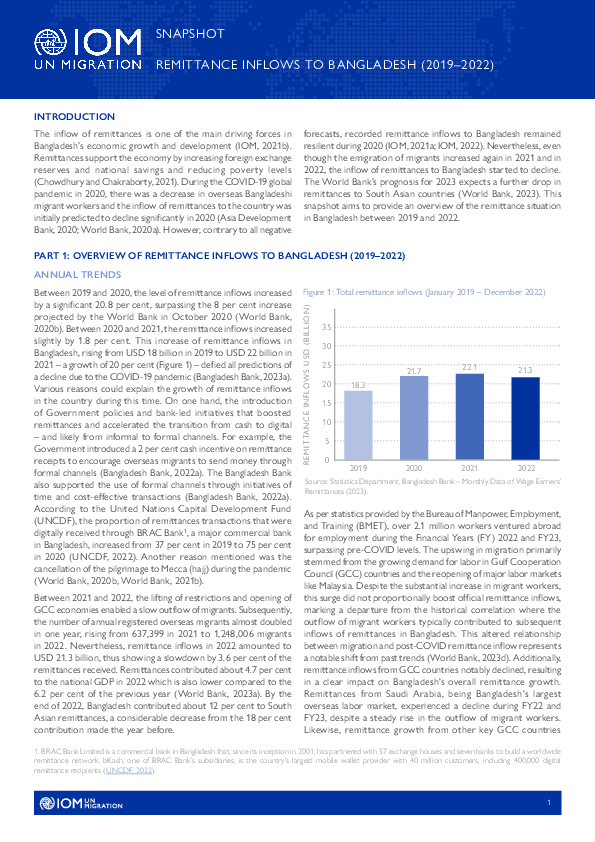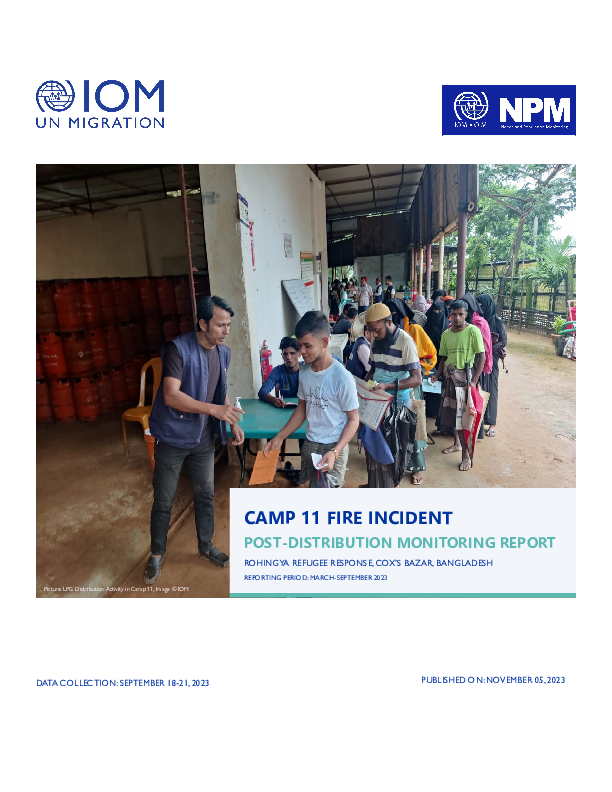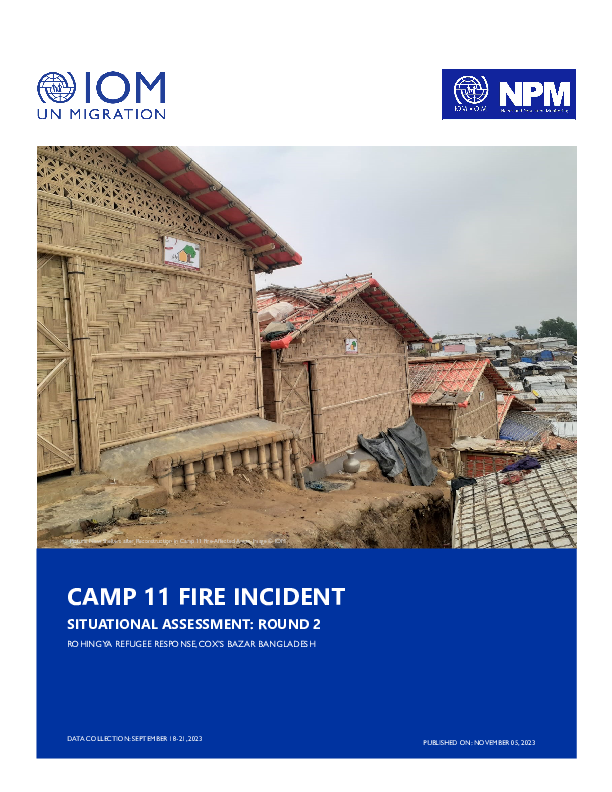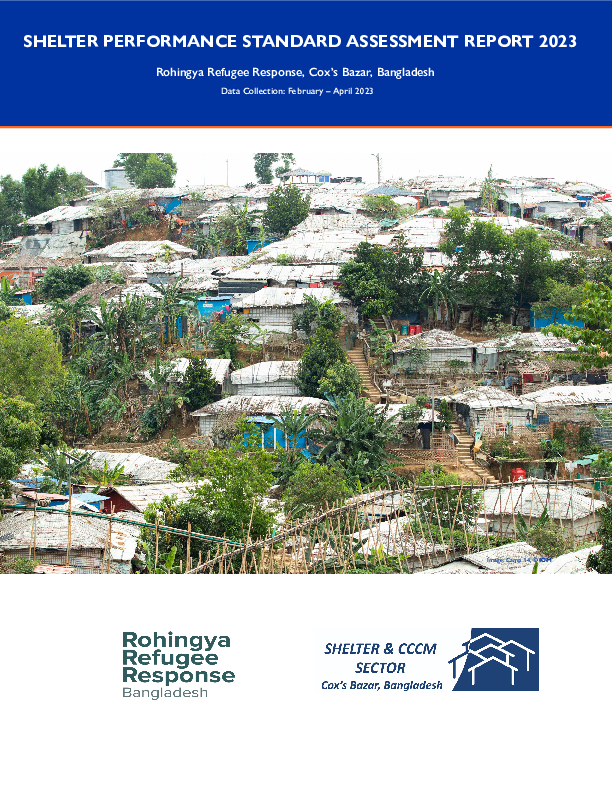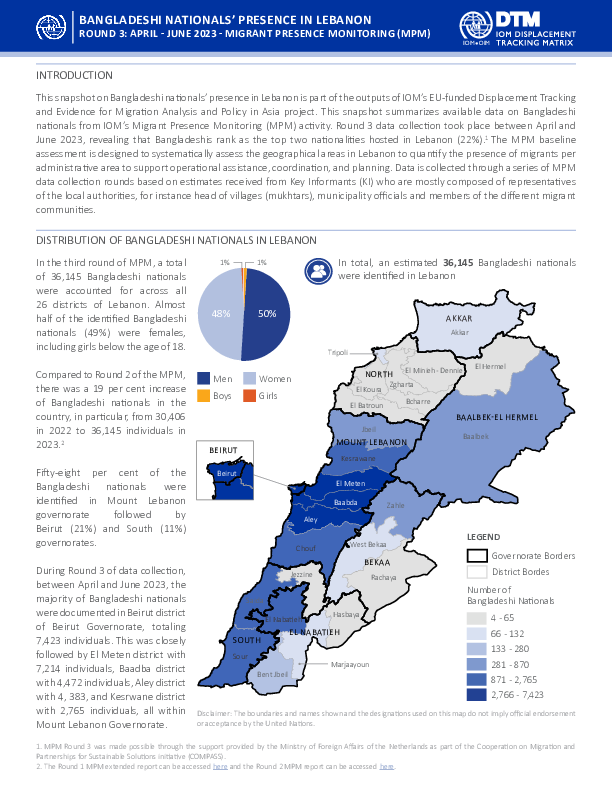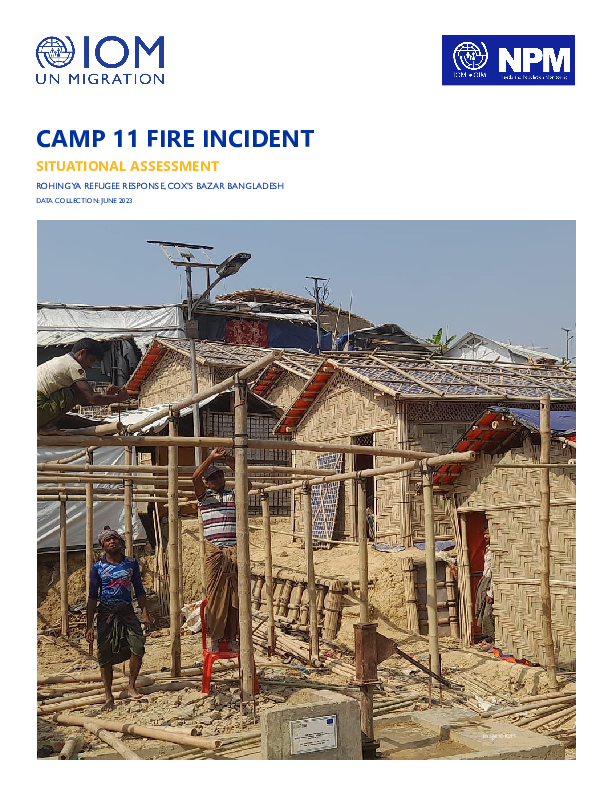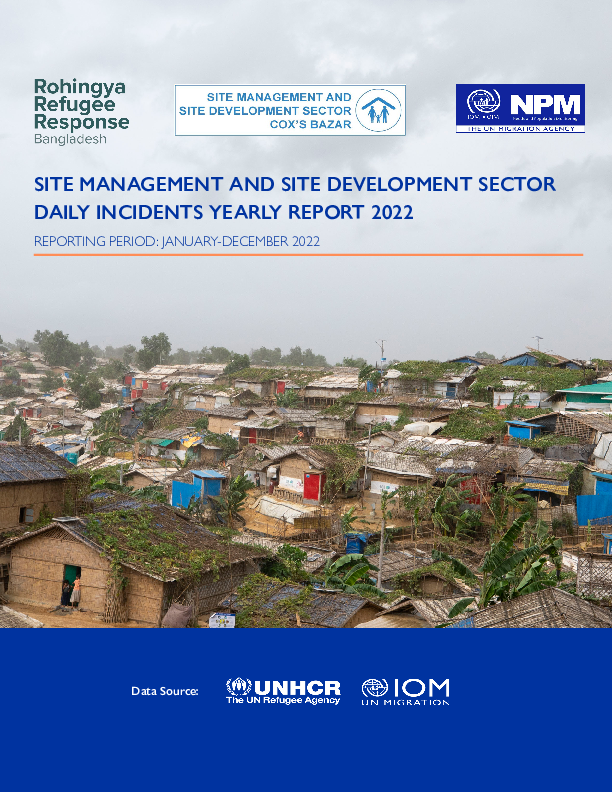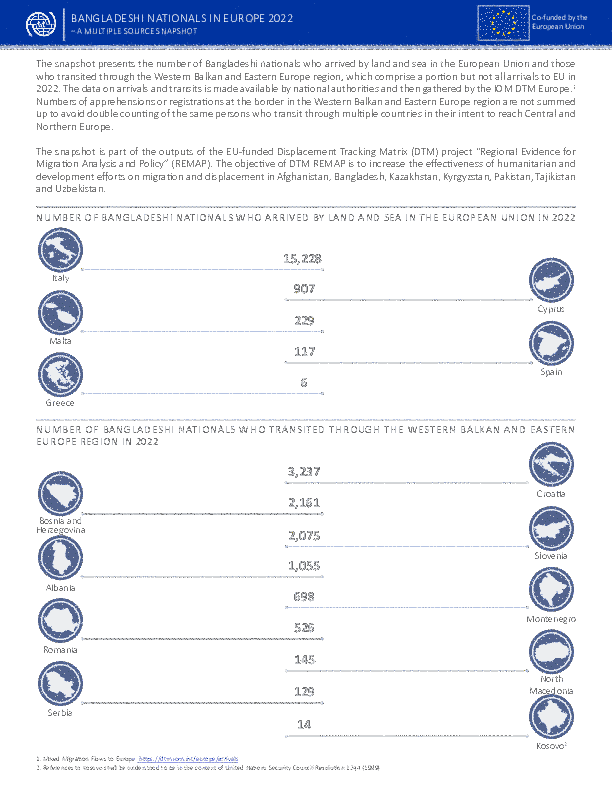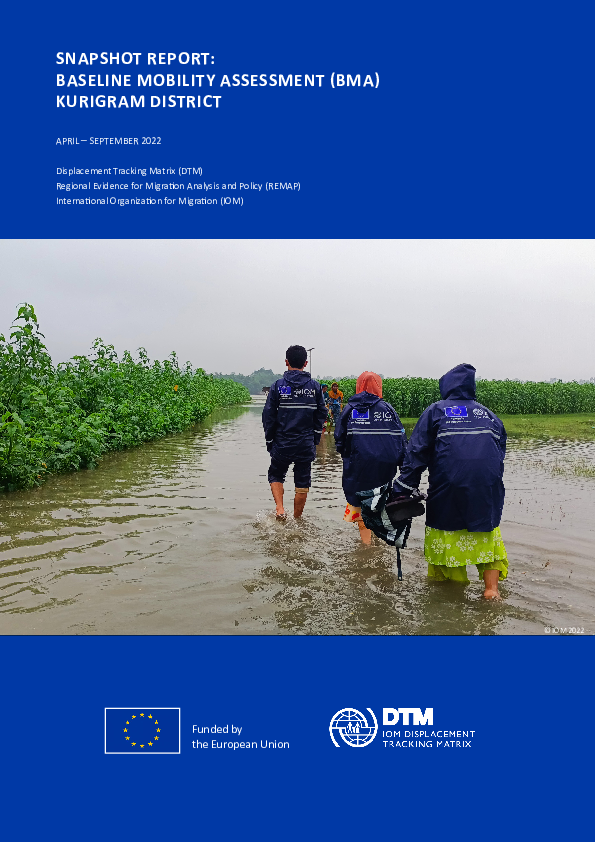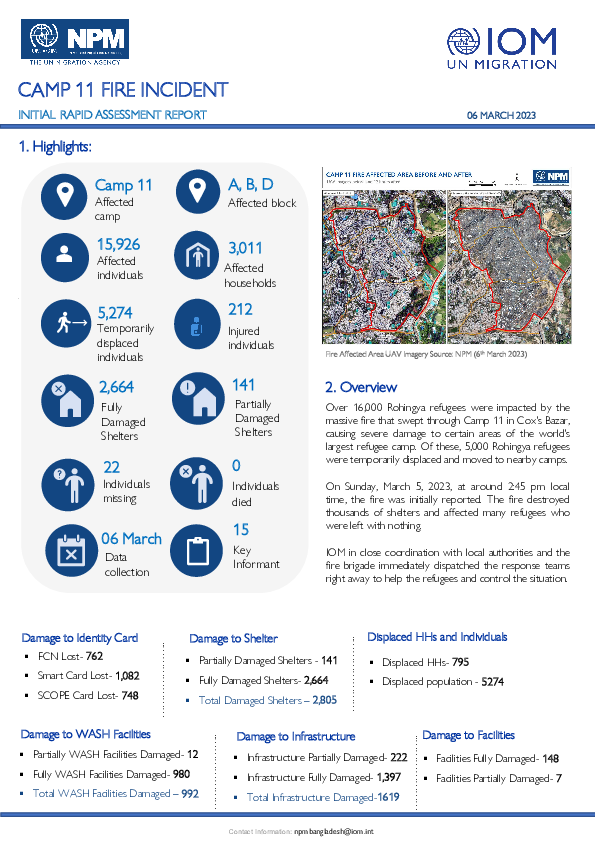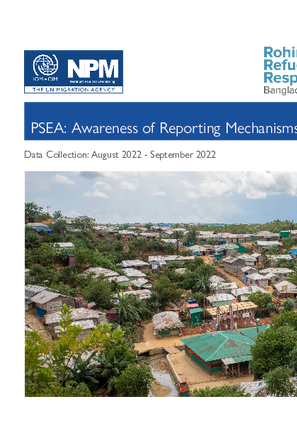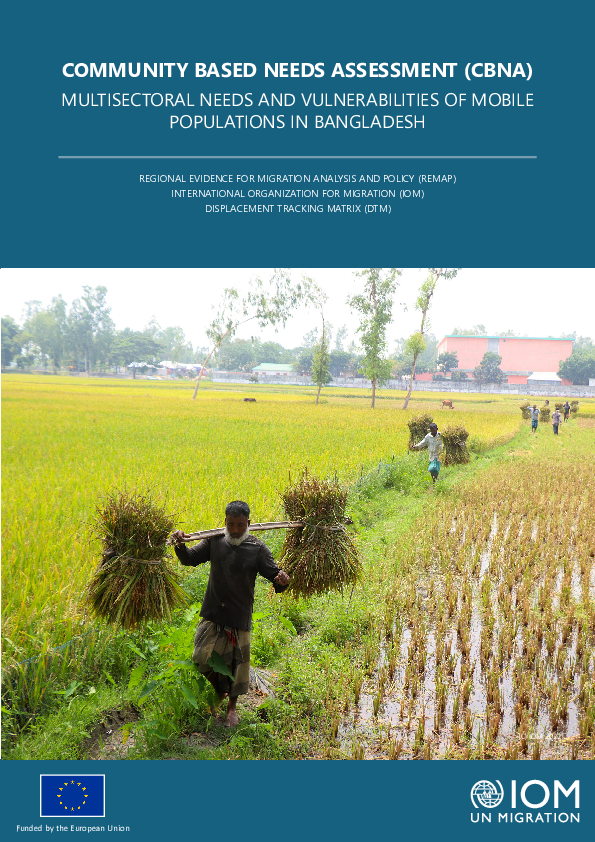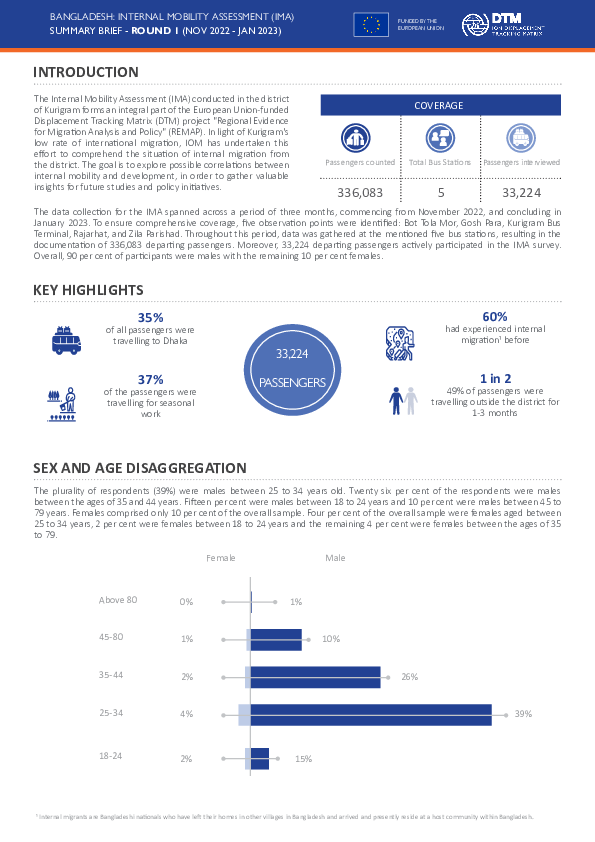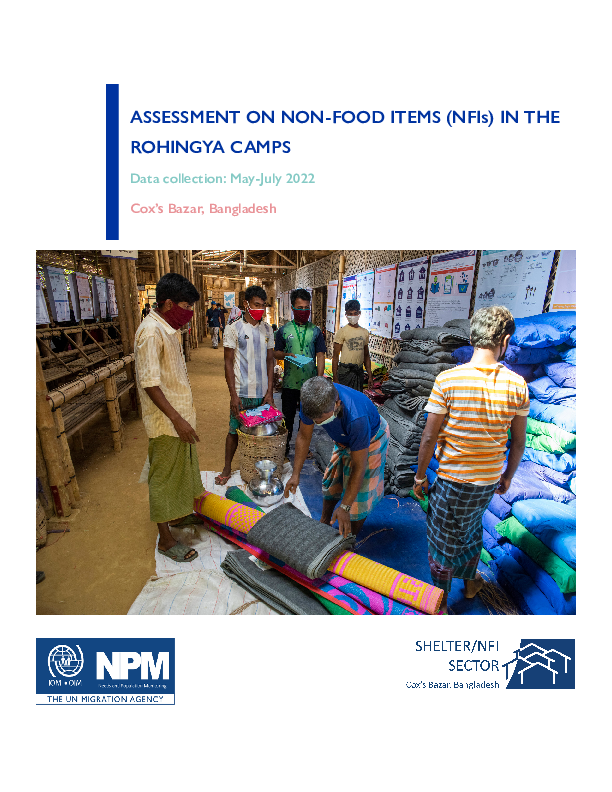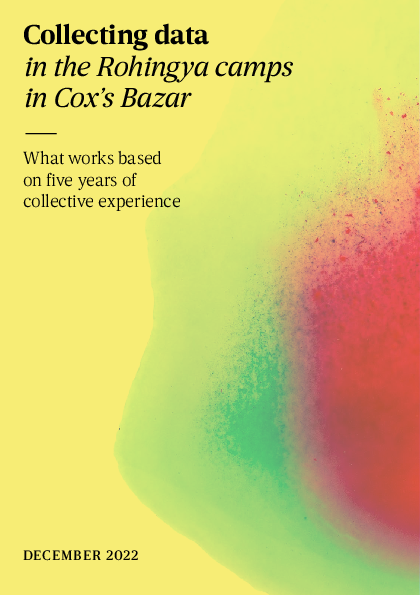-
Countries
-
Data and Analysis
-
Special Focus
-
Crisis Responses
Bangladesh
Bangladesh
IDPs tracked
Displacement Movements
426,000
IDMC 2023
Data collection round
About Bangladesh
IOM Bangladesh Needs and Population Monitoring (NPM) tracks population numbers, movements and needs to inform the Rohingya humanitarian response in Cox Bazar. IOM Bangladesh Needs and Population Monitoring (NPM) is part of IOM’s global Displacement Tracking Matrix (DTM) programming. DTM is IOM’s information management system to track and monitor displacement and population mobility. It is designed to capture, process, and disseminate information to provide a better understanding of the movements and evolving needs of displaced populations, whether on-site or en route regularly and systematically. IOM Bangladesh NPM was first launched in Cox’s Bazar district in early 2017 and has consistently been a key data provider in the Rohingya humanitarian response. Access the NPM Portal for the most recent products.
IOM’s Needs and Population Monitoring (NPM) unit works to support evidence-based humanitarian decision-making and prioritization by tracking needs and vulnerabilities among both Rohingya and the host communities in Cox’s Bazar. Through NPM’s broad information management framework, service providers can access and make use of comprehensive data and analysis on the needs and vulnerabilities of affected populations, promoting more informed and nuanced humanitarian programming. NPM successfully partners and cooperates with the Inter-Sector Coordination Group (ISCG), various sectors, such as Shelter and Camp Coordination and Camp Management (SCCCM), and humanitarian partners, particularly through designing and conducting a wide range of assessments and providing ad-hoc data collection services, as well as technical information management and GIS with Drone support. In addition. Since 2018, REACH Initiative and NPM closely collaborating in the implementation of the Multi-Sectoral Needs assessments in Rohingya refugee camps and host communities. NPM has also provided field and contextual expertise to Ground Truth Solutions and Translators without Borders. These partnerships serve to strengthen NPM as a key information provider of the response.
Since 2018, IOM, with funding from the European Union, established the Displacement Tracking Matrix Regional Evidence for Migration Analysis and Policy (DTM REMAP) project, to strengthen the evidence-based formulation and implementation of humanitarian and development policy and programming on human mobility, migration, return and displacement in Bangladesh. Under DTM REMAP, IOM Bangladesh conducts various activities in a variety of districts in Bangladesh including: i) Baseline Mobility Assessments (BMA) to inform on numbers and locations of Bangladeshi internal and international migrants; ii) Survey on Drivers of Migration (SDM) to improve the understanding of the drivers of out-migration among Bangladeshi (potential) migrants; iii) Returnee Longitudinal Studies (RLS) to monitor the sustainability of return and needs and vulnerabilities of returnees; iv) Community Based Needs Assessments (CBNA) to inform on characteristics, needs and vulnerabilities of Bangladeshi migrants and their communities.
Current Donors
- European Union
- Australia
- PRM
- DFID
Bangladesh - Remittance Inflows into Bangladesh (2019–2022)
The inflow of remittances is one of the main driving forces in Bangladesh’s economic growth and development (IOM, 2021b). Remittances support the economy by increasing foreign exchange reserves and national savings and reducing poverty levels (Chowdhury and Chakraborty, 2021).
Bangladesh — Camp 11 Fire Incident Post-Distribution Monitoring Report: Rohingya Refugee Response, Cox’s Bazar (November 2023)
The world’s largest refugee camp suffered significant damage in certain areas across Camp 11 after a massive fire spread through this camp on March 5, 2023. Three blocks were affected blocks (A, B, and D), with Block D having the most impacted households (1,278).
Bangladesh — Camp 11 Fire Incident Situational Assessment: Rohingya Refugee Response, Cox’s Bazar (September 2023)
The massive fire that swept through Camp 11 on March 5, 2023, affecting over 16,000 Rohingya refugees, severely damaged certain areas of the world’s largest refugee camps. Of these, 5,000 Rohingya refugees were temporarily displaced and moved to nearby camps.
Bangladesh — Awareness of reporting mechanisms for reporting general and sensitive issues in the Rohingya camps (May 2022 - April 2023)
During an emergency and time of displacement, the psychosocial implications of displaced people are affected and the breakdown of the usual protective institutions such as the family, community, government, law enforcement structures, etc. increase the intensity of different protection issues.
Bangladesh — Shelter Performance Standard Assessment Report 2023
The total number of Rohingya refugees in Cox’s Bazar and and Bhasan char is around 961,729 individuals . A high majority of the Rohingya refugee population is concentrated in 33 extremely congested camps within Ukhiya and Teknaf Upazilas of Cox’s Bazar district, Bangladesh.
Bangladesh – Bangladeshi Migrants’ Presence in Libya – March-April 2023
This snapshot on Bangladeshi migrants’ presence in Libya is part of the outputs of IOM’s EU-funded Displacement Tracking Matrix - Regional Evidence for Migration Analysis and Policy (DTM REMAP) project.
Bangladesh – Bangladeshi Nationals' Presence in Lebanon (Round 3, Migrant Presence Monitoring)
This snapshot summarizes available data on Bangladeshi nationals in Lebanon from IOM’s Migrant Presence Monitoring (MPM) Round 3. Round 3 data collection took place between April and June 2023.
Aug 15 2023
Bangladesh – Bangladeshi Nationals' Presence…
Bangladesh — Camp 11 Fire Incident Situational Assessment: Rohingya Refugee Response, Cox’s Bazar (June 2023)
The massive fire that swept through Camp 11 on March 5, 2023, affecting over 16,000 Rohingya refugees, severely damaged certain areas of the world’s largest refugee camps. Of these, 5,000 Rohingya refugees were temporarily displaced and moved to nearby camps.
Bangladesh — Site Management and Site Development Sector: Daily Incidents Yearly Report (January-December 2022)
Rohingya refugees live in the world’s largest refugee settlement in Bangladesh’s south-eastern district of Cox’s Bazar. The Myanmar military attack on Rakhine state in August 2017 forced thousands of Rohingya Muslims to escape to Bangladesh.
Bangladesh — Camp Based Needs Assessment in IOM’s AoR Rohingya Refugee Response, Cox’s Bazar (October - December 2022)
After the Burmese military’s violent assault on Rohingya Muslims in Rakhine Province began in August 2017, when thousands of Rohingya people fled their homes with severe persecution resulting in the creation of the world’s largest refugee camps in Bangladesh.
Bangladesh — Cyclone Mocha: 72 Hours Joint Needs Assessment Report, Rohingya Refugee Response (May 2023)
On May 14 at around 15:00 hrs., Cyclone Mocha hit the coastal areas along the Bangladesh-Myanmar border.
Bangladesh — Camp 11 Fire Incident: In-Depth Rapid Needs Assessment, Rohingya Refugee Response (March 2023)
A massive and devastating fire that broke out through Camp 11 on 5th March 2023, affected nearly 16,000 Rohingya refugees and causing severe damage to certain areas of the world’s largest refugee camp in Cox’s Bazar.
Bangladesh – Bangladeshi Nationals in Europe – A Multiple Source Snapshot (2022)
The snapshot presents the number of Bangladeshi nationals who arrived by land and sea in the European Union and those who transited through the Western Balkan and Eastern Europe region, which comprise a portion but not all arrivals to EU in 2022.
Bangladesh — Satkhira District: Baseline Mobility Assessment (May — August 2022)
The Baseline Mobility Assessment (BMA) is part of the European Union-funded Displacement Tracking Matrix (DTM) project "Regional Evidence for Migration Analysis and Policy" (REMAP).
Bangladesh — Kurigram District: Baseline Mobility Assessment (April — September 2022)
The Baseline Mobility Assessment (BMA) is part of the European Union-funded Displacement Tracking Matrix (DTM) project "Regional Evidence for Migration Analysis and Policy" (REMAP).
Bangladesh — Camp 11 Fire Incident: Initial Rapid Assessment Report (March 2023)
Over 16,000 Rohingya refugees were impacted by the massive fire that swept through Camp 11 in Cox's Bazar, causing severe damage to certain areas of the world's largest refugee camp. Of these, 5,000 Rohingya refugees were temporarily displaced and moved to nearby camps.
Bangladesh — PSEA: Awareness of Reporting Mechanisms for Sensitive Issues in the Rohingya Camps (August-September 2022)
In the displacement contexts, it is likely that the psychosocial implications of displacement and the breakdown of the usual protective institutions such as the family, community, government, law enforcement structures, etc. increases the intensity of different protection issues.
Bangladesh – Community Based Needs Assessment (March - September 2022)
This report serves to present the findings from the Community-Based Needs Assessment conducted by DTM between March and September 2022 in Kurigram District, Bangladesh.
Bangladesh — Internal Mobility Assessment (IMA) – Kurigram District (November 2022 – January 2023)
The Internal Mobility Assessment (IMA) conducted in the district of Kurigram forms an integral part of the European Union-funded Displacement Tracking Matrix (DTM) project "Regional Evidence for Migration Analysis and Policy" (REMAP).
Bangladesh — Assessment on Non-Food Items (NFIs) in the Rohingya Camps (May-July 2022)
It has been five years since Rohingya refugees fled from Myanmar to Bangladesh, however the humanitarian response still remains focused on meeting humanitarian needs.
Bangladesh — Rohingya Hobor: Constricted Movement and Limited Livelihoods, Edition 4 (Feb - July 2022)
Rohingyar Hobor (Rohingya news) is a regular trends report produced by IOM Needs and Population Monitoring (NPM), IOM’s Protection Unit (Research and Consultations team), and ACAPS.
Bangladesh – Rapid Needs Assessment 3 (May - June 2022)
As the COVID-19 pandemic emerged globally, migrant workers, both internationally and within Bangladesh, found themselves facing a new set of challenges and vulnerabilities.
Bangladesh — Collecting Data in the Rohingya Camps in Cox’s Bazar (January 2018 - December 2022)
Data collection in humanitarian response is based on established standards, guidelines, and good practices that have evolved over time. While these practices give a general structure for data collection processes, they need to be adaptable to any specific response context.
Bangladesh — Rohingya Crisis Response — Needs and Priorities of Rohingya Refugees and Host Communities in Cox’s Bazar Since 2017: What Has Changed (January 2018 - December 2022)
August 2017 and the months that followed saw the influx of more than 700,000 Rohingya refugees fleeing violence in Myanmar’s Rakhine state to Cox’s Bazar, Bangladesh. This influx brought the Rohingya refugee population in Cox’s Bazar to over 900,000 (IOM 31/03/2022).
Pagination
Bangladesh — Site Assessment — Round 17
2020-01-28
A site assessment is a sub-component of mobility tracking. It aims to collect data on population presence, living conditions and needs in a particular displacement site or community.
Bangladesh — Site Assessment — Round 16
2019-10-10
A site assessment is a sub-component of mobility tracking. It aims to collect data on population presence, living conditions and needs in a particular displacement site or community.
Bangladesh — Site Assessment — Round 15
2019-06-24
A site assessment is a sub-component of mobility tracking. It aims to collect data on population presence, living conditions and needs in a particular displacement site or community.
Bangladesh — Site Assessment — Round 14
2019-02-13
A site assessment is a sub-component of mobility tracking. It aims to collect data on population presence, living conditions and needs in a particular displacement site or community.
Bangladesh - Site Assessment Round 6
2018-11-28
A site assessment is a sub-component of mobility tracking. It aims to collect data on population presence, living conditions and needs in a particular displacement site or community.
Bangladesh — Site Assessment — Round 13
2018-11-20
A site assessment is a sub-component of mobility tracking. It aims to collect data on population presence, living conditions and needs in a particular displacement site or community.
Bangladesh — Site Assessment — Round 12
2018-10-10
A site assessment is a sub-component of mobility tracking. It aims to collect data on population presence, living conditions and needs in a particular displacement site or community.
Bangladesh — Site Assessment — Round 11
2018-07-22
A site assessment is a sub-component of mobility tracking. It aims to collect data on population presence, living conditions and needs in a particular displacement site or community.
Bangladesh — Site Assessment — Round 10
2018-05-20
A site assessment is a sub-component of mobility tracking. It aims to collect data on population presence, living conditions and needs in a particular displacement site or community.
Bangladesh — Site Assessment — Round 9
2018-03-25
A site assessment is a sub-component of mobility tracking. It aims to collect data on population presence, living conditions and needs in a particular displacement site or community.
Bangladesh - Site Assessment Round 8
2018-02-08
A site assessment is a sub-component of mobility tracking. It aims to collect data on population presence, living conditions and needs in a particular displacement site or community.
Bangladesh — Site Assessment — Round 7
2017-12-12
A site assessment is a sub-component of mobility tracking. It aims to collect data on population presence, living conditions and needs in a particular displacement site or community.
Bangladesh — Site Assessment — Round 5
2017-09-25
A site assessment is a sub-component of mobility tracking. It aims to collect data on population presence, living conditions and needs in a particular displacement site or community.
Bangladesh - Site Assessment Round 4
2017-08-03
A baseline assessment is a sub-component of mobility tracking. It aims to collect data on IDP, migrant or returnee population presence in a defined administrative area of the country.
Bangladesh - Site Assessment Round 3
2017-06-22
A baseline assessment is a sub-component of mobility tracking. It aims to collect data on IDP, migrant or returnee population presence in a defined administrative area of the country.
Bangladesh - Site Assessment Round 2
2017-05-02
A baseline assessment is a sub-component of mobility tracking. It aims to collect data on IDP, migrant or returnee population presence in a defined administrative area of the country.
Bangladesh - Site Assessment Round 1
2017-03-28
A baseline assessment is a sub-component of mobility tracking. It aims to collect data on IDP, migrant or returnee population presence in a defined administrative area of the country.


